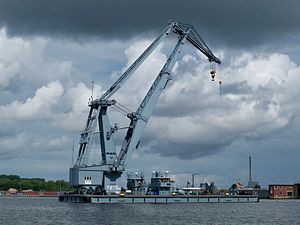Design
The self-propelled floating cranes have a triple diesel-electric drive, each consisting of a MWM four-stroke 16-cylinder diesel engine with 442 kW, a three-phase generator with 700 kVA, a direct current drive motor with 350 kW and a Voith-Schneider propeller. One of the propellers is in the bow area, the other two in the stern area.
The double-link luffing jib crane is a MAN product. The lifting capacities are 100 t with a radius of 16.2 m and 50 t with a radius of 28.5 m and a maximum hook height of 35 m above the waterline.
A galley, living quarters for twelve people and workshops allow a sea mission of up to ten days. [1]
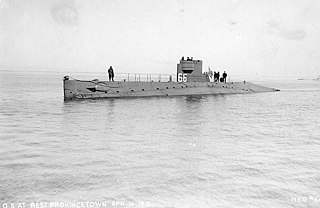
USS O-5 (SS-66) was one of 16 O-class submarines built for the United States Navy during World War I.

Sevmorput is a Russian nuclear-powered cargo ship. The 1988-built vessel is one of only four nuclear-powered merchant ships ever built and, after returning to service in 2016 following an extensive refit, the only such vessel to remain in service as of 2022.

The Saipem 7000 is the world's third largest semi-submersible crane vessel, after the SSCV Sleipnir and the SSCV Thialf. It is owned by the oil and gas industry contractor Saipem S.p.A.

A crane vessel, crane ship or floating crane is a ship with a crane specialized in lifting heavy loads. The largest crane vessels are used for offshore construction. Conventional monohulls are used, but the largest crane vessels are often catamaran or semi-submersible types as they have increased stability. On a sheerleg crane, the crane is fixed and cannot rotate, and the vessel therefore is manoeuvered to place loads.

HMS D1 was one of eight D-class submarine built for the Royal Navy during the first decade of the 20th century.
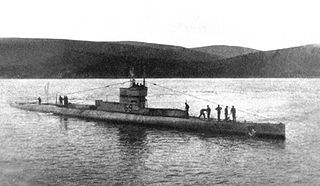
HMS G3 was a British G-class submarine built for the Royal Navy during World War I.

HMS G10 was a British G-class submarine built for the Royal Navy during World War I.

The Bougainville class was a group of colonial avisos, or sloops, built for the French Navy during the 1930s. They were designed to operate in the remote locations of the French Empire.
Histria Perla is a Chemical/Oil Products Tanker managed by the Romanian shipping company Histria Shipmanagement and is registered in Valletta, Malta.
Histria Coral is a Chemical/Oil Products Tanker owned by the Romanian shipping company Histria Shipmanagement and is registered in Valletta, Malta.

ARA Bahía San Blas is an amphibious cargo ship of the Argentine Navy, capable of unloading landing craft, troops, vehicles and cargo. She is the first Argentine Navy ship to bear the name of San Blas Bay of in the south of Buenos Aires Province.
The Beardmore Crane was a giant cantilever crane at the William Beardmore and Company yard.

Ajax is a floating crane built to move and install the canal locks and other large parts of the Panama canal. Ajax also helped in ship repairs and clearing the canal as needed. Ajax and her identical sister crane, the Hercules, were the largest floating cranes at time of completion, able to install the massive Panama Canal locks. Ajax could lift a maximum of 250 tons to a height of 21 feet, with a close reach. At Ajax's far reach she could lift a maximum of 100 tons. Ajax and Hercules were built by Deutsche Maschinenbau AG (1910-1977) . After the Ajax and Hercules, Deutsche Maschinenbau AG later made the Langer Heinrich, or Long Henry in 1915, in use for 100 years.

Langer Heinrich, or in English Long Henry, is a floating crane commissioned in 1915 for the Wilhelmshaven Imperial Shipyard in Wilhelmshaven, Germany and has been located in Genoa, Italy since 1997. At the time of completion she was the largest floating crane in the world, passing up the Ajax crane barge completed in 1914.

An auxiliary floating drydock is a type of US Navy floating dry dock. Floating dry docks are able to submerge underwater and to be placed under a ship in need of repair below the water line. Water is then pumped out of the floating dry dock, raising the ship out of the water. The ship becomes blocked on the deck of the floating dry dock for repair. Most floating dry docks have no engine and are towed by tugboats to their destinations. Floating dry docks come in different sizes to accommodate varying ship sizes, while large floating dry docks come in sections and can be combined to increase their size and lift power. Ballast pontoon tanks are flooded with water to submerge or pumped dry to raise the ship.
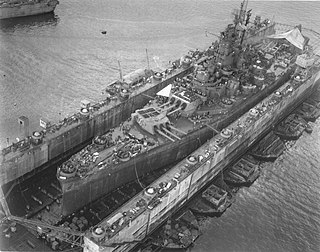
ABSD-6 is an advanced base sectional dock which was constructed of nine advance base docks (ABD) sections for the US Navy as an auxiliary floating drydock for World War II. ABSD-6 was built by Mare Island Naval Shipyard at Vallejo, California. ABSD-6 was commissioned on 28 September 1944. Advance Base Sectional Dock-6 was constructed in sections during 1942 and 1943. Each section are 3,850 tons and are 93 feet long each. Each Section had a 165 feet beam, a 75 feet molded depth and had 10,000 tons lifting capacity each. There were 4 ballast compartments in each section. With all nine sections joined, she was 825 feet long, 28 feet tall, and with an inside clear width of 133 feet 7 inches. ABSD-2 had a traveling 15-ton capacity crane with an 85-foot radius and two or more support barges. The two side walls were folded down under tow to reduce wind resistance and lower the center of gravity. ABSD-6 had 6 capstans for pulling, each rated at 24,000 lbf (110,000 N) at 30 ft/min (0.15 m/s), 4 of the capstans were reversible.
Everett-Pacific Shipbuilding & Dry Dock Company was established in 1942 to build ships needed for World War II. As part of the Emergency Shipbuilding Program the US Navy provided some of the capital to start Everett-Pacific Shipbuilding at Port Gardner Bay in Everett, Washington. Everett-Pacific was sold in 1945 to the Pacific Car and Foundry, who was already a major manufacturer of railcars and trucks. Pacific Car and Foundry was building barges for the US Navy during World War II at plants in Renton, Seattle and Tacoma in the state of Washington. The lease for the shipyard in Everett, Washington ended in 1949 and the yard closed. Pacific Car and Foundry in 1972 changed its name to Paccar Inc. to reflect its major products. The Everett-Pacific shipyard site later became part of Western Gear, a heavy machinery manufacturer. in 1987 the shipyard became part of Naval Station Everett. Everett-Pacific Shipbuilding was started by William Pigott Jr. a Seattle businessmen and his brother Paul Pigott (1900-1961). William Pigott Jr. was born in 26 Aug. 1895 in Pueblo, CO and died on 8 July 1947 in San Francisco, CA.

The Arrol Gantry was a large steel structure built by Sir William Arrol & Co. at the Harland and Wolff shipyard in Belfast, Ireland. It was built to act as overhead cranes for the building of the three Olympic-class liners.
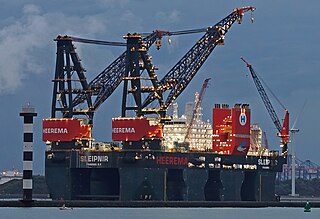
SSCV Sleipnir is a semi-submersible crane vessel (SSCV) owned and operated by Heerema Marine Contractors. It is named for Sleipnir, the eight-legged horse ridden by Odin in Norse mythology. The vessel is equipped with two revolving cranes built by Huisman Equipment B.V., each with a capacity of 10,000 t ; the main cranes can be operated in tandem to jointly lift 20,000 t. It was ordered in 2015 and built in Singapore by Sembcorp Marine. After its completion in 2019, SSCV Sleipnir succeeded Heerema's earlier SSCV Thialf as the largest crane vessel in the world.
VOS Prudence was built as an offshore supply vessel for the shipping company Vroon Offshore Services.
